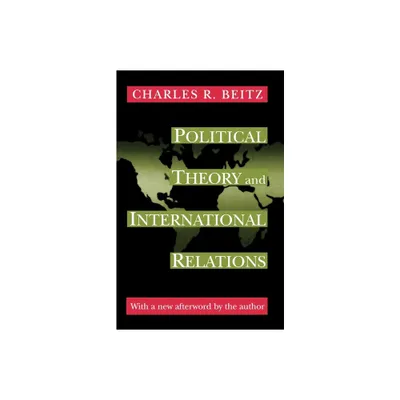Home
Judicial Interpretation of Political Theory; A Study in the Relation of the Courts to the American Party System
Loading Inventory...
Barnes and Noble
Judicial Interpretation of Political Theory; A Study in the Relation of the Courts to the American Party System
Current price: $9.99


Barnes and Noble
Judicial Interpretation of Political Theory; A Study in the Relation of the Courts to the American Party System
Current price: $9.99
Loading Inventory...
Size: OS
*Product Information may vary - to confirm product availability, pricing, and additional information please contact Barnes and Noble
Party conviction has always been "recognized as an essential qualification for the supreme bench in addition to legal learning and public service." In substantiation of this general observation, the author, in his introduction, points out that "only ardent supporters of a strong federal system were elevated to the bench by Washington and Adams." Unanimity in the early opinions herein finds its explanation. The only apparent exception to the conclusion that party conviction was an essential qualification to a position on the supreme bench the author finds to be in the offer of the chief justiceship to Patrick Henry by President Washington in the fall of 1795-96, despite the fact that Henry had been the ablest and most influential opponent of constitutional ratification in Virginia.
The volume reviews the partisan character of many leading cases, including such typical instances as Hepburn v. Griswold, a reversal by the supreme court for which political influence has been held responsible, and the "decisions in the insular cases and the decisions growing out of the Inter-State Commerce Act" which have "carried loose construction to its ultimate limit."
Criticisms of the supreme court have been made from the time of the earlier cases on the power of the courts to declare congressional acts unconstitutional, through the Dred Scott case, the prize cases, the legal tender cases, the income tax decisions, to the criticism of the Democratic platform of 1904 in which the Republican party is held responsible for forcing "strained, unnatural constructions upon the statutes by virtue of its control of the judiciary."
The respective chapters include intimate and thorough-going discussions of the judicial power over legislative enactments: theory of constitutional construction; nature of the federal Union; imperialism v. expansion; the theory of internal improvements; the theory of the United States bank; the theory of legal tender; the theory of a protective tariff; the theory of an income tax; the theory of direct legislation; and the theory of the recall of judicial decisions. Of these important and far-reaching problems of our national life, the constitutionality of internal improvements and the constitutionality of the recall of judicial decisions only have not been officially determined by the supreme court of the United States.
The volume contains few new facts but it does contain an interesting array of facts, cogently put and interestingly related. "The courts have been able to settle the metes and bounds of practically every [party] issue considered, with the exception of that of slavery." The author extols the "supreme confidence" that the American people have imposed in their federal courts, and finds that "it is fortunate that this confidence exists for it insures the country against riots and civil strife, resulting from heated debate and party antagonism."
The volume is valuable because it brings together the legal and constitutional phases of the most prominent planks in partisan platforms, and indicates through its every page the close relation between the federal judicial tribunals and the solution of political, social and economic problems.
—Annals of the American Academy of Political and Social Science [1915]
The volume reviews the partisan character of many leading cases, including such typical instances as Hepburn v. Griswold, a reversal by the supreme court for which political influence has been held responsible, and the "decisions in the insular cases and the decisions growing out of the Inter-State Commerce Act" which have "carried loose construction to its ultimate limit."
Criticisms of the supreme court have been made from the time of the earlier cases on the power of the courts to declare congressional acts unconstitutional, through the Dred Scott case, the prize cases, the legal tender cases, the income tax decisions, to the criticism of the Democratic platform of 1904 in which the Republican party is held responsible for forcing "strained, unnatural constructions upon the statutes by virtue of its control of the judiciary."
The respective chapters include intimate and thorough-going discussions of the judicial power over legislative enactments: theory of constitutional construction; nature of the federal Union; imperialism v. expansion; the theory of internal improvements; the theory of the United States bank; the theory of legal tender; the theory of a protective tariff; the theory of an income tax; the theory of direct legislation; and the theory of the recall of judicial decisions. Of these important and far-reaching problems of our national life, the constitutionality of internal improvements and the constitutionality of the recall of judicial decisions only have not been officially determined by the supreme court of the United States.
The volume contains few new facts but it does contain an interesting array of facts, cogently put and interestingly related. "The courts have been able to settle the metes and bounds of practically every [party] issue considered, with the exception of that of slavery." The author extols the "supreme confidence" that the American people have imposed in their federal courts, and finds that "it is fortunate that this confidence exists for it insures the country against riots and civil strife, resulting from heated debate and party antagonism."
The volume is valuable because it brings together the legal and constitutional phases of the most prominent planks in partisan platforms, and indicates through its every page the close relation between the federal judicial tribunals and the solution of political, social and economic problems.
—Annals of the American Academy of Political and Social Science [1915]


















